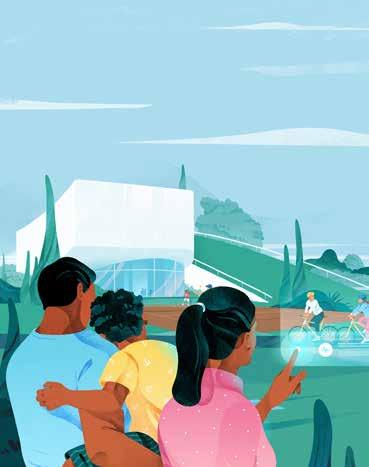
6 minute read
Social Equity
Is COVID-19 Uncovering Park Inequities?
By Kimberly Burrowes O ver the past six months, COVID-19 has brought more than a health crisis — it has impacted the way we live and work in our communities across the nation. With policies (tinyurl.com/ rdtxsef) encouraging people to practice physical distancing, enact curfews and shelter in place, there are now less interactions in the public realm to slow the spread of the disease. The U.S. National Park Service, along with local government-managed park and recreation departments, face challenges keeping parks open to encourage physical activity and promote good mental health. Park system leaders also recognize that park space may prompt large gatherings and expose employees to health risks by maintaining the green spaces. While ensuring access to parks is an opportunity to diversify daily life, it creates a severe concern for advancing the spread of COVID-19.
Advertisement
Yet, even amidst this balancing act, there is the growing recognition that access to parks and recreational spaces are not equitable (tpl.org/10MinuteWalk). There are several communities that have historically lacked access to parks and continue to remain disconnected in a time when getting outdoors is one of the few permissible activities. In many cities across the United States, there are fewer quality parks in close proximity to low-income residents and communities of color, and even
when they live close by, they are less likely to frequent these spaces. Barriers, like perception of public safety, park entry fees and perceived racial discrimination, have prevented residents across the more vulnerable income, education and race groups from accessing parks. Examining the value of parks in a time of physical distancing can help unearth the inequities in the types and quality of spaces available for residents and determine if the communities’ values and priorities are being addressed.
Prioritizing Equitable Investments in COVID-19
In citywide budget cuts, park agency funding is one of the first to go, although parks have tremendous benefits. Parks and green space promote physical activities, encourage mental well-being, are valuable for the environment and bring communities together. While many cities have closed their large parks to uphold the CDC’s physical distancing restrictions, others have embraced the opportunity for residents to utilize the outdoors. According to the Rails-to-Trails Conservancy, the nationwide trail use grew by 200 percent from March 16 to 22.
As we move from response to recovery to resilience in this period of COVID-19, there is an opportunity to apply the observations of park inequities to improve future park development and programming. These lessons were adapted from the 2019 Urban Institute report, “Investing in Equitable Urban Park Systems” (tinyurl.com/rsb8lal). They were always essential for inclusive city planning but are now even more important as community resilience strategies.
1Leveraging funding through
multiple sources. Parks are mostly funded through traditional city sources, such as budget appropriations, dedicated tax and revenues, or earned fees. As priorities shift for COVID-19, many of these funding streams are dwindling or non-existent. Now is the time for park agencies to align investments with other local programs and policies, to tap new
funding in creative ways, while benefiting the community.
Braiding and blending funding from different sources, such as philanthropic giving, federal grants and local bonds can be strategies to provide additional capital for parks. The Yonkers Greenway project (tinyurl.com/yx35nesk) in New York unlocked multiple sources of funding — state Department of Transportation funding, U.S. Environmental Protection Agency brownfield funds and state environmental funds — to revitalize the downtown area with a large park.
2Engaging resident support in under-resourced communi
ties. Smaller cities with financial constraints have to think creatively to source support for the operations and maintenance of parks and green space. Capital funding for parks is more likely to come from non-traditional sources, whereas taking care of and programming existing assets have typically come from the city or state. With this limitation in mind, the city of Brownsville, Texas, leveraged $3 million worth of volunteer hours for the maintenance of its parks through the Keep Brownsville Beautiful program. Involving the residents both eased the financial burden of maintaining the park and ensured they found value in the community asset.
3Increasing park equity through health system part
ners. Health equity is an important consideration during COVID-19 and a significant benefit of parks. Kaiser Permanente and the California Wellness Foundation funded the HEAL Cities Campaign for Complete Parks Systems (tinyurl.com/ ueb43fh) to improve access to and active use of parks. Residents in Colton and Placentia, California, were engaged through advocacy workshops, planning meetings and other forms of stakeholder consultation to offer input in the planning and implementation of more equitable park policies. As a consequence of this, park agencies can demonstrate the health benefits of parks to encourage not just an increase in use, but also more funding.
COVID-19 has uncovered inequities in park quality and access that always existed in communities. These strategies, among several others, can help park agencies to remain resilient, but these alone will not be enough. Closing the park equity gap will require park and recreation agency leaders and their partners in government and communities to work together. New forms of funding will need to be aligned with citywide equity frames and complement national initiatives for inclusion (nrpa. org/ParksForInclusion). When equity is placed at the center of park investments (cityparksalliance.org/Equitable-ParkFunding) and funding decisions, the benefits are better positioned for residents and the city is more inclusive.
Kimberly Burrowes is a Technical Assistance Specialist with the Research to Action Lab at the Urban Institute (kburrowes@urban.org).

Boost Resident Experiences with Tech By Alex Gauthier
As I physically distance myself and work on this article from home in late March, I can’t help but wonder where we’d be without technology. If the COVID-19 crisis has emphasized anything, it’s the importance of technology to keep the public and private sectors from falling apart. Leveraging technology to improve park and recreation operations and community engagement is not unheard of. Everywhere you look, you are bound to find stakeholders who are either resisting tech or trying to be its cheerleader. There’s no denying that technology is at the heart of communities looking to stay connected and engaged, even if they can’t be together physically.
The time has never been better to evaluate how we choose to invest in and take advantage of the digital tools at our disposal. Every interaction an agency has with its residents is an experience; technology can help deliver an experience that is as impressive online as it is offline. As more and more people get accustomed to evaluating choices online before making a decision, park and recreation agencies must be ready to engage with residents by leveraging everything technology has to offer.
So what does tech have to offer? For starters, it helps agencies set up more efficient processes so that leaders can focus on finding i nnovative ways to better engage all, not some, community segments. Tech helps monitor which initiatives engage communities and which don’t, and course-correct in real time instead of at end-of-year reviews. Pure software as a service tech ensures agency operations remain relatively unaffected and on track (especially during exceptional times) by keeping their platforms running and ready to handle an influx of traffic. And finally, tech helps park and recreation professionals pave the way for future-proof agencies that are not only financially sustainable, but also at par with the online experiences that residents have come to expect in the digital age.
Visit smartrec.com to discover how to put your residents first. Alex Gauthier is Chief Operating Officer at Amilia (alex.g@amilia.com).










